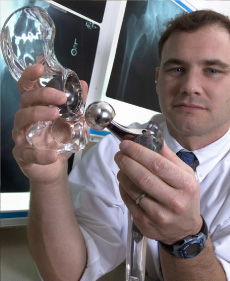Resurfacing for hipsters

Hip resurfacing preserves the way a normal hip moves and feels, says orthopaedic surgeon Thomas Bradbury. |
by Tia McCollors
Emory orthopaedic surgeon Thomas Bradbury knew he found an ideal patient for hip resurfacing surgery.
The woman, age 50, had been incapacitated with hip pain so severe that it had kept her from working on the farm or riding horses for more than a year. But within eight weeks of undergoing surgery, she got her life back. She once again was able to ride horseback and do her chores on the farm.
This alternative to traditional total hip replacement allows patients to preserve more natural bone and more accurately restores natural anatomy. The procedure is particularly appealing for younger patients, who want to retain quality of life through their more active years.
Bradbury identifies two advantages of hip resurfacing over total hip replacement. "For the patient, the procedure preserves the way a normal hip moves and feels, allowing a greater stability and range of motion," he says. "And if future work needs to be done, preserving the bone stock makes it easier for the physician to make repairs later on."
|
|
Although European doctors have been performing total hip resurfacing since the early 1990s, the FDA only approved it in 2006 in the United States. Since then, the number of hip resurfacing procedures has been on the rise, including at Emory, where resurfacing makes up approximately 10% of the volume of hip arthroplasty procedures performed.
Both total hip replacement and total hip resurfacing involve the ball and socket of the hip joint. With resurfacing, the damaged hip ball is reshaped, then covered with a metal cap. The resulting bigger hip ball may reduce the risk of dislocation after it is attached to a polished metal socket. By contrast, with traditional total hip replacement, the ball of the hip is completely removed and replaced with a metal prosthesis. It is then set into a metal socket covered with an inner liner.
"Total hip resurfacing is more difficult than a standard primary total hip replacement because of the required precise fit of the metal ball cap and a more challenging exposure to insert the metal socket," says Emory orthopaedic surgeon Greg Erens, who also performs the new procedure.
The surgery is not for everyone. People who are significantly obese or have osteoporosis, kidney disease, or brittle or dead bone are not good candidates for the procedure. It works best for young, active patients who have significant arthritis of the hip but still retain good bone quality with little hip deformity.



